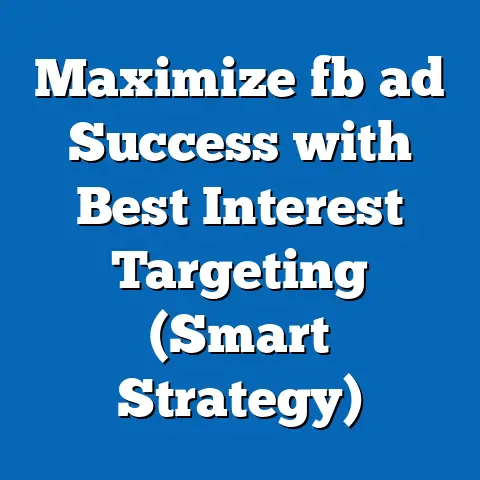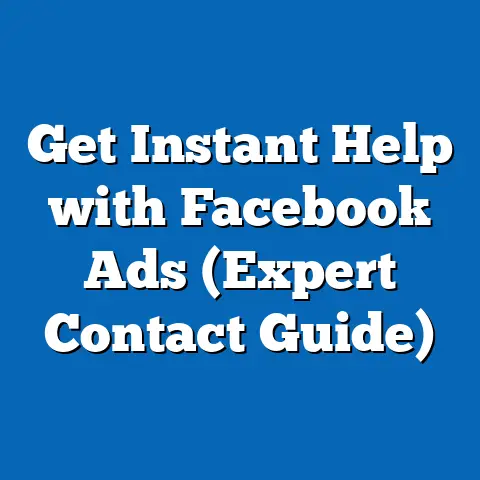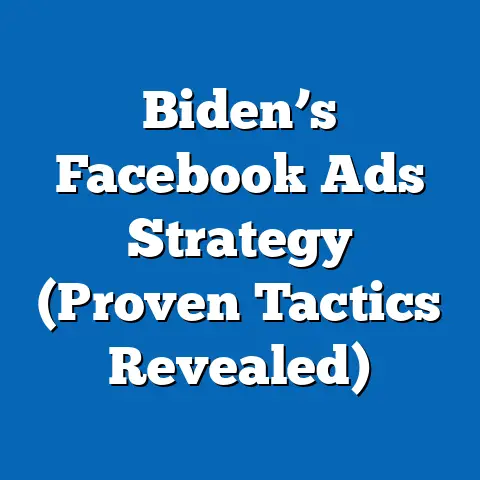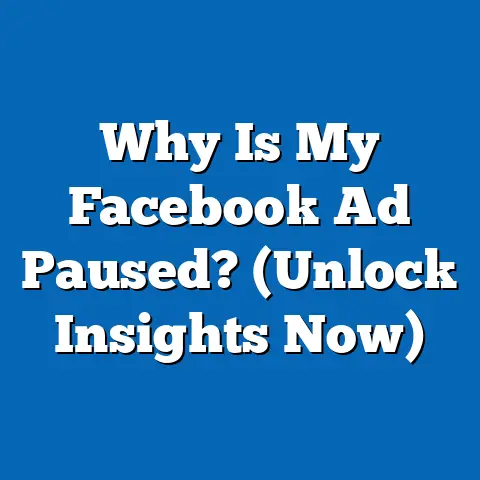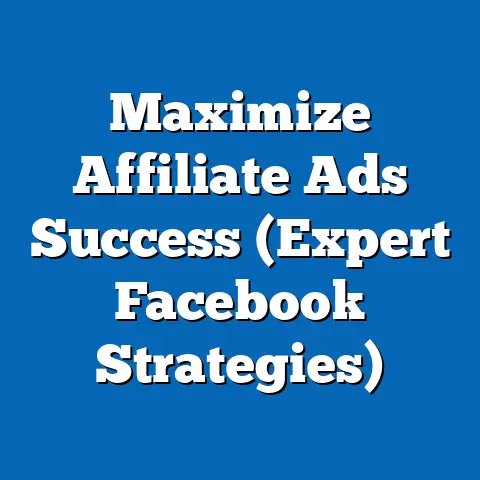Add Cards to Facebook Ads (Unlock Engagement Secrets)
In today’s digital landscape, every penny counts, especially for small businesses and startups. I’ve seen firsthand how quickly advertising costs can spiral out of control, leaving you wondering where your budget went and what you got in return. Traditional advertising methods often come with a hefty price tag, making it difficult for smaller players to compete. That’s where Facebook Ads come in – offering a more affordable and targeted approach to reach your audience. But even with Facebook Ads, it’s crucial to find ways to maximize your impact without blowing your budget. One of the most effective, yet often overlooked, tools in your Facebook Ads arsenal is the use of “Cards.”
I’m talking about Carousel Ads, Collection Ads, and even Video Ads with interactive elements. These aren’t just pretty visuals; they’re powerful engagement drivers that can significantly boost your ad performance without a massive increase in spend. In this guide, I’ll dive deep into the world of Facebook Ads Cards, showing you exactly how to add them to your campaigns, why they work, and how to measure their success. Get ready to unlock engagement secrets and make your advertising budget work harder than ever before!
Understanding Facebook Ads and Their Cost-Effectiveness
Facebook Ads have revolutionized the way businesses connect with their target audiences. Instead of relying on broad, untargeted methods like TV or print ads, Facebook Ads allow you to pinpoint your ideal customer based on demographics, interests, behaviors, and more. This level of precision translates to a more efficient use of your advertising dollars.
Let’s talk numbers. The average cost-per-click (CPC) on Facebook Ads can range from $0.50 to $2.00, while the cost-per-impression (CPM) typically falls between $7 and $10. However, these figures can vary widely depending on your industry, target audience, ad quality, and bidding strategy. I’ve personally managed campaigns where the CPC was as low as $0.30 due to highly targeted audiences and compelling ad creatives.
Compared to traditional media, the ROI potential of Facebook Ads is undeniable. A well-executed Facebook Ads campaign can generate a significantly higher return on investment than a traditional print ad or a radio spot. Think about it: you’re reaching people who are actively interested in what you have to offer, and you’re only paying when they engage with your ad.
Now, where do Cards fit into this cost-effective equation? Cards, in the context of Facebook Ads, are interactive ad formats that allow you to showcase multiple products, services, or features within a single ad unit. By strategically integrating Cards into your campaigns, you can maximize engagement, drive more traffic, and ultimately achieve a higher ROI without dramatically increasing your ad spend. It’s about working smarter, not harder.
Key Takeaway: Facebook Ads offer a cost-effective alternative to traditional advertising, and Cards can help you maximize engagement and ROI within your Facebook Ads campaigns.
What Are Cards in Facebook Ads?
In the realm of Facebook Ads, “Cards” refer to visually rich and interactive ad formats that allow you to present multiple pieces of content within a single ad unit. Think of them as mini-presentations within your ad, giving users a more engaging and informative experience.
Here’s a breakdown of the most common types of Cards you’ll encounter:
- Carousel Ads: These are arguably the most well-known type of Card. Carousel Ads allow you to display multiple images or videos, each with its own headline, description, and call-to-action. Users can swipe through the cards to view different products, features, or aspects of your brand. I’ve used Carousel Ads extensively to showcase product lines, tell brand stories, and highlight different features of a service.
- Collection Ads: Collection Ads are designed for e-commerce businesses. They feature a hero image or video at the top, followed by a selection of product images below. When users click on the ad, they are taken to a full-screen experience where they can browse and purchase products directly from Facebook. I’ve seen Collection Ads work wonders for clothing retailers, furniture stores, and other businesses with a wide range of products.
- Instant Experience Ads (formerly Canvas Ads): While not technically “Cards” in the traditional sense, Instant Experience Ads offer a similar interactive experience. When users click on an Instant Experience Ad, they are taken to a full-screen, mobile-optimized landing page within Facebook. This allows you to create a rich and immersive experience without sending users to an external website. I’ve used Instant Experience Ads to showcase product demos, tell in-depth brand stories, and create interactive games.
- Video Cards: These Cards use video content to captivate the audience. They often include interactive elements like clickable buttons or quizzes, enhancing engagement. I once created a video card for a local restaurant that allowed viewers to explore the menu and make reservations directly from the ad.
The power of Cards lies in their visual appeal. They’re more engaging than static images because they offer a dynamic and interactive experience. Instead of just seeing one image, users can explore multiple products, learn more about your brand, and even make a purchase – all within a single ad.
Key Takeaway: Cards in Facebook Ads are visually rich and interactive ad formats that allow you to present multiple pieces of content within a single ad unit, leading to higher engagement rates.
Benefits of Using Cards in Facebook Ads for Cost-Effective Engagement
The benefits of using Cards in Facebook Ads extend far beyond just aesthetics. They’re strategic tools that can significantly improve your ad performance and ROI, all while keeping your costs in check.
- Higher Engagement Rates: Cards are inherently more engaging than static images. The ability to swipe, click, and explore multiple pieces of content keeps users interested and encourages them to interact with your ad. I’ve consistently seen engagement rates (likes, comments, shares, clicks) increase when using Cards compared to single-image ads.
- Increased Click-Through Rates (CTR): Because Cards are more engaging, they naturally lead to higher click-through rates. When users are presented with multiple options or compelling visuals, they’re more likely to click on your ad and visit your website or landing page. In one particular campaign for a travel agency, I saw a 50% increase in CTR when switching from a single-image ad to a Carousel Ad showcasing different vacation destinations.
- Improved Conversion Rates: Higher engagement and CTR ultimately translate to improved conversion rates. When users are more engaged with your ad, they’re more likely to take the desired action, whether it’s making a purchase, filling out a form, or signing up for a newsletter.
- Showcasing Multiple Products or Stories: Cards allow you to showcase multiple products, services, or aspects of your brand within a single ad unit. This is particularly useful for e-commerce businesses with a wide range of products or for brands that want to tell a more complete story. I remember working with a local brewery that used Carousel Ads to highlight their different beers, each with its own unique description and tasting notes. This allowed them to showcase their entire product line in a single ad, driving more traffic to their taproom.
- Maximizing Advertising Real Estate: With Cards, you’re essentially getting more bang for your buck. You’re using the same amount of ad space to display more information and engage users in a more meaningful way. This is especially important in today’s competitive advertising landscape, where every impression counts.
I’ve seen countless campaigns where the use of Cards has made a significant difference in ad performance. It’s not just about having a pretty ad; it’s about creating an engaging and informative experience that resonates with your target audience and drives results.
Key Takeaway: Cards in Facebook Ads drive higher engagement rates, increase click-through rates, improve conversion rates, and allow you to showcase multiple products or stories within a single ad unit, maximizing the usage of advertising real estate.
Step-by-Step Guide to Adding Cards to Your Facebook Ads
Now that you understand the benefits of using Cards, let’s get into the practical steps of adding them to your Facebook Ads campaigns.
-
Accessing the Ads Manager: The first step is to navigate to Facebook Ads Manager. You can do this by clicking on the “Ads Manager” link in the left-hand menu of your Facebook page or by going directly to
facebook.com/adsmanager. -
Choosing the Right Campaign Objective: Before creating your ad, you need to choose a campaign objective that aligns with your goals. Common objectives include:
- Traffic: Driving traffic to your website or landing page.
- Conversions: Encouraging users to take a specific action on your website, such as making a purchase or filling out a form.
- Engagement: Increasing engagement with your Facebook page or posts.
- Lead Generation: Collecting leads from potential customers.
- Selecting Card Formats: Once you’ve chosen your campaign objective, you can select the appropriate Card format.
- Carousel Ads: To create a Carousel Ad, select the “Traffic” or “Conversions” objective and choose “Carousel” as your ad format.
- Collection Ads: To create a Collection Ad, select the “Conversions” objective and choose “Collection” as your ad format.
- Instant Experience Ads: To create an Instant Experience Ad, select the “Traffic,” “Conversions,” or “Engagement” objective and add an Instant Experience to your ad.
- Uploading Visuals and Writing Engaging Text: This is where the magic happens. For Carousel Ads, you’ll need to upload multiple images or videos, each with its own headline, description, and call-to-action. For Collection Ads, you’ll need to select a hero image or video and choose the products you want to feature. For Instant Experience Ads, you’ll need to design the entire experience, including images, videos, text, and interactive elements.
Tips for optimizing Card content:
- Use High-Quality Images: Make sure your images are clear, crisp, and visually appealing.
- Write Concise Text: Keep your headlines and descriptions short and to the point.
- Use Strong Call-to-Actions: Tell users exactly what you want them to do (e.g., “Shop Now,” “Learn More,” “Sign Up”).
- Maintain Brand Consistency: Ensure your ad content aligns with your overall brand aesthetic and messaging.
- Setting the Budget and Targeting the Right Audience: Finally, you’ll need to set your budget and target your audience. Facebook Ads allows you to target users based on demographics, interests, behaviors, and more. I recommend starting with a small budget and gradually increasing it as you optimize your campaign.
Accessing the Ads Manager: The first step is to navigate to Facebook Ads Manager. You can do this by clicking on the “Ads Manager” link in the left-hand menu of your Facebook page or by going directly to facebook.com/adsmanager.
Choosing the Right Campaign Objective: Before creating your ad, you need to choose a campaign objective that aligns with your goals. Common objectives include:
- Traffic: Driving traffic to your website or landing page.
- Conversions: Encouraging users to take a specific action on your website, such as making a purchase or filling out a form.
- Engagement: Increasing engagement with your Facebook page or posts.
- Lead Generation: Collecting leads from potential customers.
- Selecting Card Formats: Once you’ve chosen your campaign objective, you can select the appropriate Card format.
- Carousel Ads: To create a Carousel Ad, select the “Traffic” or “Conversions” objective and choose “Carousel” as your ad format.
- Collection Ads: To create a Collection Ad, select the “Conversions” objective and choose “Collection” as your ad format.
- Instant Experience Ads: To create an Instant Experience Ad, select the “Traffic,” “Conversions,” or “Engagement” objective and add an Instant Experience to your ad.
- Uploading Visuals and Writing Engaging Text: This is where the magic happens. For Carousel Ads, you’ll need to upload multiple images or videos, each with its own headline, description, and call-to-action. For Collection Ads, you’ll need to select a hero image or video and choose the products you want to feature. For Instant Experience Ads, you’ll need to design the entire experience, including images, videos, text, and interactive elements.
Tips for optimizing Card content:
- Use High-Quality Images: Make sure your images are clear, crisp, and visually appealing.
- Write Concise Text: Keep your headlines and descriptions short and to the point.
- Use Strong Call-to-Actions: Tell users exactly what you want them to do (e.g., “Shop Now,” “Learn More,” “Sign Up”).
- Maintain Brand Consistency: Ensure your ad content aligns with your overall brand aesthetic and messaging.
- Setting the Budget and Targeting the Right Audience: Finally, you’ll need to set your budget and target your audience. Facebook Ads allows you to target users based on demographics, interests, behaviors, and more. I recommend starting with a small budget and gradually increasing it as you optimize your campaign.
I’ve found that A/B testing different Card formats and content variations is crucial for maximizing performance. Don’t be afraid to experiment and see what works best for your target audience.
Key Takeaway: Adding Cards to your Facebook Ads involves accessing the Ads Manager, choosing the right campaign objective, selecting Card formats, uploading visuals and writing engaging text, and setting the budget and targeting the right audience.
Measuring Success: Analyzing the Impact of Cards on Engagement
Creating engaging Cards is only half the battle. You also need to track your results and analyze the impact of Cards on your ad performance. This is where Facebook Insights comes in.
Here are the key performance indicators (KPIs) you should be tracking:
- Engagement Rate: This measures the percentage of users who interacted with your ad (likes, comments, shares, clicks). A higher engagement rate indicates that your ad is resonating with your target audience.
- Click-Through Rate (CTR): This measures the percentage of users who clicked on your ad after seeing it. A higher CTR indicates that your ad is compelling and relevant to your target audience.
- Conversion Rate: This measures the percentage of users who took the desired action after clicking on your ad (e.g., making a purchase, filling out a form). A higher conversion rate indicates that your ad is effectively driving results.
- Cost-Per-Click (CPC): This measures the cost you pay each time someone clicks on your ad. A lower CPC indicates that your ad is efficiently driving traffic to your website or landing page.
- Return on Ad Spend (ROAS): This measures the revenue you generate for every dollar you spend on advertising. A higher ROAS indicates that your ad is generating a positive return on investment.
To analyze the effectiveness of Cards in your ad campaigns, go to Facebook Insights and look at the performance of your ads that use Cards compared to your ads that don’t. Pay attention to the KPIs listed above and see if there are any significant differences.
I’ve found that ongoing adjustments and testing different Card formats is crucial for maximizing engagement. Don’t be afraid to experiment with different headlines, descriptions, images, and call-to-actions to see what resonates best with your target audience.
Key Takeaway: Measuring success with Cards in Facebook Ads involves tracking key performance indicators (KPIs) such as engagement rate, CTR, conversion rate, CPC, and ROAS, and making ongoing adjustments and testing different Card formats to maximize engagement.
Conclusion
In conclusion, using Cards in Facebook Ads is a cost-effective strategy that can significantly enhance engagement and improve your ad performance. Cards not only provide a visually appealing way to connect with your audience but also serve as a budget-friendly option for advertisers.
Remember, the key to success with Cards is to create compelling content that resonates with your target audience. Use high-quality images, write concise text, and use strong call-to-actions. Don’t be afraid to experiment with different Card formats and content variations to see what works best for you.
I encourage you to experiment with Cards in your own campaigns and see the difference they can make. By leveraging the right tools and strategies, you can achieve significant improvements in ad performance and engagement without breaking the bank.
So, what are you waiting for? Take action today and start adding Cards to your Facebook Ads campaigns! Your audience (and your budget) will thank you for it.

